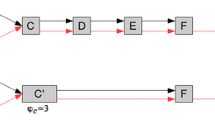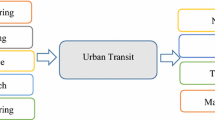Abstract
High-frequency transit systems are essential for the socioeconomic and environmental well-being of large and dense cities. The planning and control of their operations are important determinants of service quality. Although headway and optimization-based control strategies generally outperform schedule-adherence strategies, high-frequency operations are mostly planned with schedules, in part because operators must observe resource constraints (neglected by most control strategies) while planning and delivering service. This research develops a schedule-free paradigm for high-frequency transit operations, in which trip sequences and departure times are optimized in real-time, employing stop-skipping strategies and utilizing real-time information to maximize service quality while satisfying operator resource constraints. Following a discussion of possible methodological approaches, a simple methodology is applied to operate a simulated transit service without schedules. Results demonstrate the feasibility of the new paradigm.






Similar content being viewed by others
References
Abkowitz M, Lepofsky M (1990) Implementing headway-based reliability control on transit routes. J Transp Eng 116(1):49–63
Adenso-Díaz B, González MO, González-Torre P (1999) On-line timetable re-scheduling in regional train services. Transp Res Part B Methodol 33(6):387–398. doi:10.1016/S0191-2615(98)00041-1
Barnett A (1974) On controlling randomness in transit operations. Transp Sci 8(2):102–116
Bartholdi JJ, Eisenstein DD (2012) A self-coördinating bus route to resist bus bunching. Transp Res 46B(4):481–491. doi:10.1016/j.trb.2011.11.001
Berrebi SJ, Watkins KE, Laval JA (2015) A real-time bus dispatching policy to minimize passenger wait on a high frequency route. Transp Res Part B Methodol 81:377–389
Boyle D, Pappas J, Boyle P, Nelson B, Sharfarz D, Benn H (2009) TCRP Report 135: controlling system costs: basic and advanced scheduling manuals and contemporary issues in transit scheduling. Transportation Research Board, Washington, DC
Cats O, Larijani AN, Koutsopoulos HN, Burghout W (2011) Impacts of holding control strategies on transit performance: bus simulation model analysis. Transp Res Record 2216:51–58
Ceder A (2007) Public transit planning and operation: theory, modeling and practice. Elsevier, Butterworth-Heinemann, Oxford
Corman F, D’Ariano A, Pacciarelli D, Pranzo M (2010) A tabu search algorithm for rerouting trains during rail operations. Transp Res Part B Methodol 44(1):175–192. doi:10.1016/j.trb.2009.05.004
Corman F, D’Ariano A, Pacciarelli D, Pranzo M (2012) Bi-objective conflict detection and resolution in railway traffic management. Transp Res Part C Emerg Technol 20(1):79–94. doi:10.1016/j.trc.2010.09.009
Cortés CE, Jara-Díaz S, Tirachini A (2011) Integrating short turning and deadheading in the optimization of transit services. Transp Res Part A Policy Pract 45(5):419–434. doi:10.1016/j.tra.2011.02.002
Daganzo CF, Pilachowski J (2011) Reducing bunching with bus-to-bus cooperation. Transp Res 45B(1):267–277
D’Ariano A, Pacciarelli D, Pranzo M (2007) A branch and bound algorithm for scheduling trains in a railway network. Eur J Oper Res 183(2):643–657. doi:10.1016/j.ejor.2006.10.034
D’Ariano A, Pacciarelli D, Pranzo M (2008) Assessment of flexible timetables in real-time traffic management of a railway bottleneck. Transp Res Part C Emerg Technol 16(2):232–245. doi:10.1016/j.trc.2007.07.006
Delgado F, Muñoz JC, Giesen R (2012) How much can holding and/or limiting boarding improve transit performance? Transp Res Part B Methodol 46(9):1202–1217
Desaulniers G, Hickman M (2007) Public transit. In: Barnhart C, Laporte G (eds) Handbooks in OR and MS 14: transportation, pp 69–127
Eberlein XJ, Wilson NH, Bernstein D (2001) The holding problem with real-time information available. Transp Sci 35(1):1–18
Huisman D (2007) A column generation approach for the rail crew re-scheduling problem. Eur J Oper Res 180(1):163–173. doi:10.1016/j.ejor.2006.04.026
Huisman D, Wagelmans AP (2006) A solution approach for dynamic vehicle and crew scheduling. Eur J Oper Res 172(2):453–471. doi:10.1016/j.ejor.2004.10.009
Kittelson & Associates, Parsons Brinckerhoff, KFH Group, Texas A&M Transportation Institute (2013) TCRP Report 165: Transit Capacity and Quality of Service Manual, 3rd edn. Transportation Research Board
Krasemann JT (2012) Design of an effective algorithm for fast response to the re-scheduling of railway traffic during disturbances. Transp Res Part C Emerg Technol 20(1):62–78. doi:10.1016/j.trc.2010.12.004
Leiva C, Muñoz JC, Giesen R, Larrain H (2010) Design of limited-stop services for an urban bus corridor with capacity constraints. Transp Res Part B Methodol 44(10):1186–1201. doi:10.1016/j.trb.2010.01.003
Mazzarello M, Ottaviani E (2007) A traffic management system for real-time traffic optimisation in railways. Transp Res Part B Methodol 41(2):246–274. doi:10.1016/j.trb.2006.02.005
Mesquita M, Paias A (2008) Set partitioning/covering-based approaches for the integrated vehicle and crew scheduling problem. Comput Oper Res 35(5):1562–1575. doi:10.1016/j.cor.2006.09.001
Osuna EE, Newell GF (1972) Control strategies for an idealized public transportation system. Transp Sci 6(1):52–72
Rezanova NJ, Ryan DM (2010) The train driver recovery problem—a set partitioning based model and solution method. Comput Oper Res 37(5):845–856. doi:10.1016/j.cor.2009.03.023
Rodriguez J (2007) A constraint programming model for real-time train scheduling at junctions. Transp Res Part B Methodol 41(2):231–245. doi:10.1016/j.trb.2006.02.006
Sáez D, Cortés CE, Milla F, Núñez A, Tirachini A, Riquelme M (2012) Hybrid predictive control strategy for a public transport system with uncertain demand. Transportmetrica 8(1):61–86
Şahin S (1999) Railway traffic control and train scheduling based oninter-train conflict management. Transp Res Part B Methodol 33(7):511–534. doi:10.1016/S0191-2615(99)00004-1
Sánchez-Martínez GE (2015) Real-time operations planning and control of high-frequency transit. Ph.D. thesis, Massachusetts Institute of Technology
Sánchez-Martínez G, Koutsopoulos H, Wilson N (2016) Real-time holding control for high-frequency transit with dynamics. Transp Res Part B Methodol 83:1–19. doi:10.1016/j.trb.2015.11.013
Site PD, Filippi F (1998) Service optimization for bus corridors with short-turn strategies and variable vehicle size. Transp Res Part A Policy Pract 32(1):19–38. doi:10.1016/S0965-8564(97)00016-5
Törnquist J, Persson JA (2007) N-tracked railway traffic re-scheduling during disturbances. Transp Res Part B Methodol 41(3):342–362. doi:10.1016/j.trb.2006.06.001
Valouxis C, Housos E (2002) Combined bus and driver scheduling. Comput Oper Res 29(3):243–259. doi:10.1016/S0305-0548(00)00067-8
Veelenturf LP, Potthoff D, Huisman D, Kroon LG (2012) Railway crew rescheduling with retiming. Transp Res Part C Emerg Technol 20(1):95–110. doi:10.1016/j.trc.2010.09.008
Vuchic VR (2005) Urban transit: operations, planning, and economics
Walker CG, Snowdon JN, Ryan DM (2005) Simultaneous disruption recovery of a train timetable and crew roster in real time. Comput Oper Res 32(8):2077–2094. doi:10.1016/j.cor.2004.02.001
Author information
Authors and Affiliations
Corresponding author
Additional information
This research was funded in part by the National Science Foundation Graduate Research Fellowship Program under Grant No. 1122374 and in part by Transport for London. This research also benefited from the support of the Bus Rapid Transit Centre of Excellence, funded by the Volvo Research and Educational Foundations (VREF), and MIT’s MISTI-Chile program.
Rights and permissions
About this article
Cite this article
Sánchez-Martínez, G.E., Wilson, N.H.M. & Koutsopoulos, H.N. Schedule-free high-frequency transit operations. Public Transp 9, 285–305 (2017). https://doi.org/10.1007/s12469-016-0129-8
Accepted:
Published:
Issue Date:
DOI: https://doi.org/10.1007/s12469-016-0129-8




